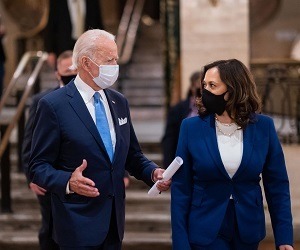
President Joe Biden and his administration submitted the fiscal year 2022 budget to Congress on June 1. The proposal totals $17.6 billion – a $2.5 billion increase from last year’s enacted level.
The Department of the Interior stated the investment will help address the climate crisis and union job creation. Healthy community lands, waters and economies are in the spotlight. The department noted President Biden’s budget makes “historic” initiatives to move forward in defeating the COVID-19 pandemic and restoring the U.S. economy.
“The Interior Department plays an important role in the president’s plan to reinvest in the American people,” Secretary Deb Haaland said. “From bolstering climate resiliency and increasing renewable energy, to supporting tribal nations and advancing environmental justice, President Biden’s budget will make much-needed investments in communities and projects that will advance our vision for a robust and equitable clean energy future.”
The budget will invest $3.5 billion in the National Park Service (NPS), with a goal to “build back better” via modern park infrastructure, conservation effort investment, expanded visitor access and bolstered traveler safety.
“President Biden’s budget supports efforts across the National Park Service to recover from the pandemic, expand the benefits of the great outdoors to all Americans and respond to the ongoing challenges of climate change,” NPS Deputy Director Shawn Benge said. “The proposed National Park Service budget of $3.5 billion, together with another $1.1 billion in mandatory funding, will allow us to make needed improvements to parks across the country, providing our visitors with better experiences and advancing the mission of the National Park Service to preserve and protect these lands unimpaired for future generations.”
At NPS, the budget would specifically support:
Responding to the Pandemic and Keeping Visitors Safe
- The president’s budget provides a $1 million increase in funding to the U.S. Public Health Service’s Commissioned Corps to expand COVID-19 testing, ensure a strong public health presence and serve communities’ public health needs across the country. The budget also includes a $10 million increase to improve lands, waters and ecosystems across the U.S. impacted by mineral extraction, which the department stated will mitigate visitor, employee and wildlife hazards. Lastly, the budget includes funding to sustain a long-term body camera program for law enforcement park rangers and U.S. Park Police to enhance public trust and accountability in law enforcement.
Expanding Visitor Access and Equity
- The budget prioritizes cultural heritage by increasing funding to American Indian Tribes by $8 million. Competitive grants totaling $5 million will be targeted at African American-directed preservation projects. The budget also includes $10 million in funding for construction at the Selma Interpretive Center, a voting rights facility that honors Civil Rights leaders such as the late Rep. John Lewis, who served Georgia’s fifth congressional district from 1987 until his death in 2020. Rehabilitation at the visitor center of the Martin Luther King, Jr. National Historical Park will receive $7.5 million.
Modernizing Parks and Park Infrastructure
- The president’s budget supports park modernization while contributing to surrounding communities’ economies. A $45 million proposal will implement the Civilian Climate Corps, which the department stated will create jobs while “mobilizing” the next generation of conservation and resilience workers. Funding made possible by the Great American Outdoors Act will support 36 projects with the bill’s National Parks and Public Land Legacy Restoration Fund. More than $1 billion is slated to target gross construction, addressing more than $835 million in deferred maintenance. The department stated funds will improve road conditions, buildings, utility systems and other assets in 29 park units across 14 states. Critical life, health and safety issues are at the forefront, as well as related code compliance and accessibility limits. The budget also includes $20 million to begin replacing the NPS-owned vehicle fleet with zero-emission models, in addition to creating necessary charging infrastructure across the park system.
Along with bolstering NPS, the president’s budget includes a $1.6 billion investment for the Bureau of Land Management (BLM). The funding will promote enhanced recreational opportunities for all Americans, the department stated, as well as promote a multiple-use and sustained yield mandate, create a conservation stewardship legacy, generate revenue and utilize natural resources.
“For the past seven decades, the Bureau of Land Management has been charged with shared public land stewardship for the American people,” said Nada Wolff Culver, BLM’s deputy director of policy and programs. “On our 75th anniversary, this proposed budget will support bold steps in conservation, restoration and tribal consultation in order to meet the president’s goal of tackling the climate crisis, while managing approximately 245 million acres of public land under our multiple-use and sustained yield mandate.”
To advance the administration’s goals, BLM’s budget would support:
Enhanced recreational opportunities
- The bureau’s 2022 budget provides “significant” resources to support enhanced recreational opportunities and access, including a $3.2 million increase in Recreation Resources Management. The investment will help restore landscape connectivity and function by enabling BLM to maintain and improve recreation sites in a manner that mitigates natural resource conflicts, such as altering traffic and concentrated use patterns.
Strengthened climate resilience and conservation partnerships
- The budget proposes $160 million in increased program funding to restore and conserve BLM-managed lands. The goal will contribute to President Biden’s initiative to conserve 30% of the nation’s lands and waters by 2030. Funding increases will target restoring landscape connectivity and function, conserving and improving lands to combat climate change, revitalizing water resources and restoring legacy disturbances, in addition to decision support for adaptive management. The BLM budget also includes $16.5 million to help establish and support a Civilian Climate Corps to support the bureau’s goals.
At the Interior Department, the budget would cover:
Addressing Climate Challenges and Building Climate Resiliency
- The proposal includes funding to help advance the America the Beautiful initiative – the administration’s effort to conserve 30% of U.S. lands and waters by 2030. The budget includes more than $900 million in funding for Interior and the Department of Agriculture for the Land and Water Conservation Fund.




